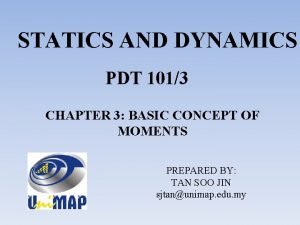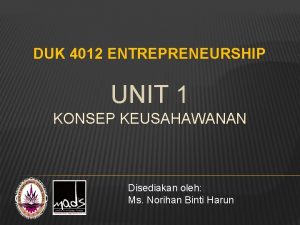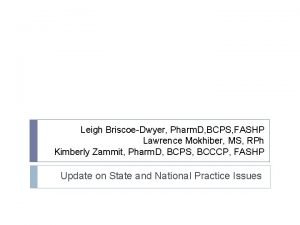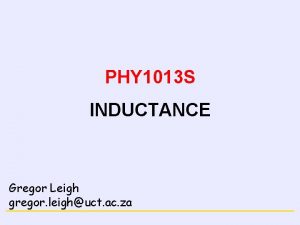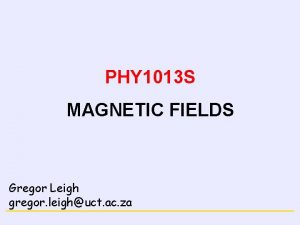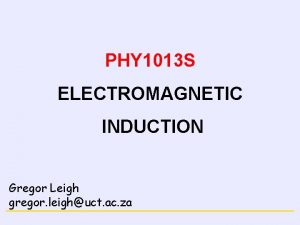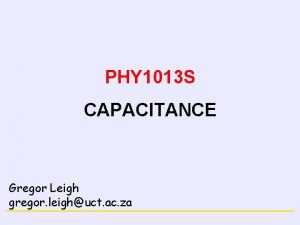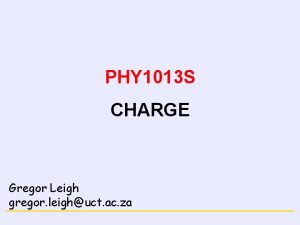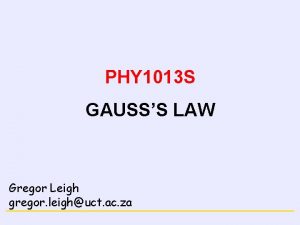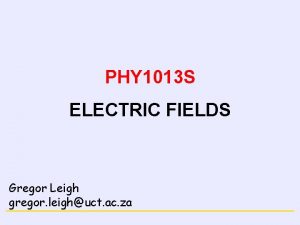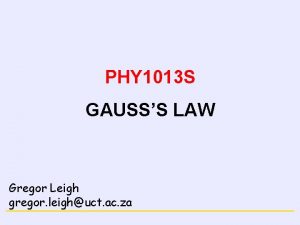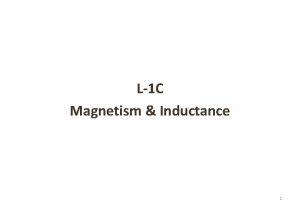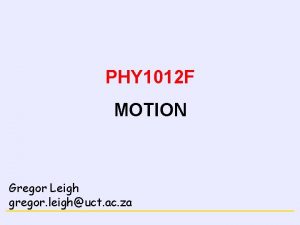MAGNETISM PHY 1013 S INDUCTANCE Gregor Leigh gregor














- Slides: 14

MAGNETISM PHY 1013 S INDUCTANCE Gregor Leigh gregor. leigh@uct. ac. za

PHY 1013 S MAGNETISM INDUCTANCE Learning outcomes: At the end of this chapter you should be able to… Recognise, describe, state the uses of, and draw the circuit diagram symbol for inductors. Determine the inductance of inductors from their geometries. Determine the energy stored in an inductor, and calculate the energy density of the magnetic field. Perform calculations involving the growth and decay of current in RL circuits. 2

PHY 1013 S MAGNETISM INDUCTANCE INDUCTORS vs CAPACITORS CAPACITOR INDUCTOR Has a capacity to “hold” charge, called capacitance… [C/V = farad, F] …determined by its geometry: Has an ability to “hold” flux, called inductance… 2 [Wb/A = T m /A = henry, H] …determined by its geometry: Circuit diagram symbol: Stores energy in its electric field: UC = ½ C( V)2 Stores energy in its magnetic field: UL = ½ LI 2 Regulates current through a series resistor… …at switch on: …and switch off: 3

PHY 1013 S MAGNETISM INDUCTANCE DETERMINING INDUCTANCE Problem-solving strategy: 1. Determine the magnetic field caused by the current I in the conductor. 2. Find the magnitude of the flux through each coil of the conductor: 3. Calculate the total flux linkage: m = N per coil (All current-carrying conductors produce inductance, but only solenoids produce enough flux and have enough turns/coils to produce significant inductance. ) 4. Determine the inductance: (Note: An ideal inductor has zero resistance. ) 4

PHY 1013 S MAGNETISM INDUCTANCE OF A SOLENOID • The flux through each coil is: per coil = AB The total flux linkage is: And since , the inductance of a solenoid is: 5

PHY 1013 S MAGNETISM INDUCTANCE VOLTAGE ACROSS AN INDUCTOR While the current through an inductor is steady there is no potential drop across it (R = 0), but changing the current… changes the flux… which induces a current… in the same coil! (Hence the term self-induction. ) As current increases in the coil, the induced current tends to “hold up” positives at the inflow, creating an electric field and hence a potential difference across the inductor: , so… induced current + increasing current VL – induced field “back emf” 6

PHY 1013 S MAGNETISM INDUCTANCE VOLTAGE ACROSS AN INDUCTOR induced current When the switch is opened, to oppose the decreasing flux in the induced field solenoid, the induced current flows – + V safety. L R decreasing in the same direction as the current decreasing current and thus establishes a “forwards” potential difference across the inductor. Since the induced emf is proportional to the rate of change of current, a rapid decrease in even a modest amount of current can produce a very high potential difference across switch contacts, leading to sparking – which may or may not be desirable. 7

PHY 1013 S MAGNETISM INDUCTANCE VOLTAGE ACROSS AN INDUCTOR Notes We use the above in conjunction with Lenz’s law. The induced emf is proportional to the rate of change of current. It is always zero for constant I. The induced current opposes the change in the input current – not the current itself. The net effect of an inductor is to make it difficult to change the current. An inductor passes DC seamlessly, but blocks AC, and is thus sometimes referred to as a choke. 8

PHY 1013 S MAGNETISM INDUCTANCE ENERGY STORED IN AN INDUCTOR The rate at which current supplies energy to an inductor is: The rate at which this energy is stored in the inductor is: i. e. the increase in energy during a time interval dt is: Hence the total amount of energy required to increase the current through the inductor from zero to I is: i. e. (Cf: ) 9

PHY 1013 S MAGNETISM INDUCTANCE ENERGY DENSITY OF A MAGNETIC FIELD As a capacitor stores energy in its electric field, so an inductor actually stores energy in its magnetic field. For a solenoid: …where is the field inside the solenoid, Hence the magnetic field energy density, u. B, inside a solenoid is: (Cf: ) 10

PHY 1013 S MAGNETISM INDUCTANCE RL CIRCUITS a In circuits containing both resistors and inductors, current strength varies with time. I. e. RL circuits are time dependent. b – decreasing I + At switch over from a to b, energy stored in the inductor allows it to act like a battery for a short period of time. Applying Kirchhoff’s loop law: i. e. L/ or: R = L is the inductive time constant for a particular circuit. Hence: …and solving for I : 11

PHY 1013 S MAGNETISM INDUCTANCE RL CIRCUITS R – decreasing I At time t = 0, I 0 = R, but as t , I 0. EL / EL + At time t = L, Graphically: I I 0 (As before, the shape of the graph is independent of L’s value. ) 0. 37 I 0 0. 13 I 0 0 L 2 L 3 L t 12

PHY 1013 S MAGNETISM INDUCTANCE RL CIRCUITS R a A long time after the switch is moved from b to a, the inductor will act like an ordinary conducting wire. b E – + increasing I EL – Initially, however, it acts to oppose the increasing current through it. Applying Kirchhoff’s loop law: I E/ solving which for I we get: R 0. 63 E/R 0 2 3 t 13

PHY 1013 S MAGNETISM INDUCTANCE INDUCTORS vs CAPACITORS CAPACITOR INDUCTOR Has a capacity to “hold” charge, called capacitance… [C/V = farad, F] …determined by its geometry: Has an ability to “hold” flux, called inductance… 2 [Wb/A = T m /A = henry, H] …determined by its geometry: Circuit diagram symbol: Stores energy in its electric field: UC = ½ C( V)2 Stores energy in its magnetic field: UL = ½ LI 2 Regulates current through a series resistor… …at switch on: …and switch off: 14

